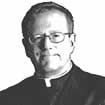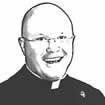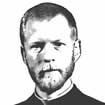
Culture
The common orientation of priest and people during the Liturgy of the Eucharist symbolizes -- or perhaps better, lives out -- the Church's conviction that the Mass is an act of worship offered to the Thrice-Holy God...

Weigel
Cardinal Robert Sarah, prefect of the Vatican's Congregation for Divine Worship and the Discipline of the Sacraments, caused a rumpus earlier this summer by proposing to a meeting of liturgists in London that the Catholic Church return to the practice of priest and people praying in the same direction during the Liturgy of the Eucharist: a change in liturgical "orientation" the cardinal described as the entire congregation looking together toward the Lord who is to come. Cardinal Sarah further proposed that bishops and priests consider implementing this change on the First Sunday of Advent this year, during the liturgical season in which expectations of the Lord's return in glory are prominent.
As readers of Evangelical Catholicism, my book on deep reform in the 21st-century Church, will remember, I proposed just such a change in the orientation of celebrant and congregation during the Liturgy of the Eucharist: priest and people would face each other during the Liturgy of the Word; celebrant and congregation would then pray together, facing the same direction, throughout the Liturgy of the Eucharist. This seemed a good "reform of the liturgical reform" to me on three counts.
First, it would underscore that the liturgy is not about us. The common orientation of priest and people during the Liturgy of the Eucharist symbolizes -- or perhaps better, lives out -- the Church's conviction that the Mass is an act of worship offered to the Thrice-Holy God, in which we the baptized are privileged to participate. Yes, the liturgy builds the Christian community and its solidarity. But that is one of its effects, not its primary purpose. Priest and people praying together "toward the Lord" can thus be a helpful antidote to the temptation to think of Mass as a ritual of communal self-affirmation -- a temptation all too common in the contemporary Culture of Me.
Second, if properly prepared by thoughtful pastors and liturgists, the re-orientation of the Liturgy of the Eucharist would help Catholics deepen our appreciation of the Kingdom dimension of the Mass. The Mass is a foretaste of the Wedding Feast of the Lamb in the New Jerusalem, described by that apostolic seer, St. John, in Revelation 21. By turning together toward the Lord-who-comes -- now, under the forms of bread and wine; later, as the Risen Lord who will hand everything over to the Father so that "God may be all in all" (1 Corinthians 15.28) -- the praying Church be regularly reminded that Christians are the people who know how the world's story is going to turn out. That assurance of God's victory over sin, suffering, and death should both comfort us and energize us for mission.
Third, returning to the practice of a common orientation during the Liturgy of the Eucharist would help mitigate the continuing problem of the priest-celebrant who imposes his own personality on the liturgy, a problem that has been exacerbated in recent decades by the celebration of the Mass versus populum -- "toward the people."
To these three reasons I might now add that a fourth -- that a reorientation of priest and people during of the Liturgy of the Eucharist would bring Latin-rite Catholic practice into harmony with the practice of the Eastern Catholic Churches and the Orthodox Churches -- and a fifth: that this re-orientation would place the reformed liturgy of Vatican II in continuity with an ancient liturgical tradition of the Church.
Any such reform of the reform must be very carefully prepared by preaching and catechesis, which will not be a matter of weeks but of months, perhaps even years. But that is itself another reason to take Cardinal Sarah's basic proposal seriously: liturgical catechesis is imperative today if the People of God are going to understand the liturgy as an act of worship that equips us for mission.
And that catechesis will have to deconstruct the nonsense that a change of orientation during the Liturgy of the Eucharist means "the priest is turning his back to the people." No, he isn't. Together, the priest-celebrant, and those who have baptized in order to offer God proper worship, are facing together toward the Lord who is to come -- and who, in coming eucharistically and in glory, brings the human drama to its fulfillment.
- George Weigel is Distinguished Senior Fellow of the Ethics and Public Policy Center in Washington, D.C.
Recent articles in the Culture & Events section
-
Tolkien's world, still popular on the big screen, began with faith and wordsCecilia Hadley
-
Scripture Reflection for Dec. 22, 2024, Fourth Sunday of AdventDeacon Greg Kandra
-
Getting adult children to Christmas MassGreg Erlandson
-
The work of redemptionEileen McLaughlin
-
Intern reflectionsEmily Greco and James Kaeser


















